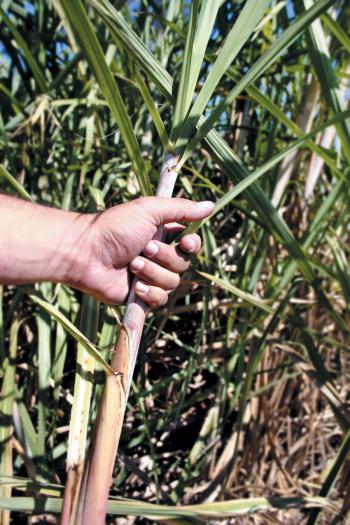
Sugarcane burning continues
For many years, fall in central and south Louisiana meant smoke causing power outages, poor visibility for drivers and ash falling from the sky.
Those were the days before the new harvesters that are able to separate the leaves from the sugarcane stalk in the field.
This now allows sugarcane growers to burn only the trash that’s left on the ground after the harvest, said LSU AgCenter sugarcane specialist Kenneth Gravois.
In years past, cane growers were concerned about carrying dead weight to the mill in the form of plant leaves. Now with the latest harvesting equipment, that is not a problem as the stalk is cut into short pieces, and the leaves are left in the field.
“So the main reason that smoke is not as big a problem as before is the cane is not standing when it’s burned now,” Gravois said.
With more than 440,000 acres of sugarcane to be harvested in the state this year, a significant amount will not be burned, Gravois said.
Because sugarcane is a perennial or multi-year crop, normally the acreage that has the stubble for next year’s growth will be burned after harvest, Gravois said. “Only the crop that will be plowed out and left fallow after harvest will not need to be burned because there will be no crop there next year.”
Less sugarcane now is burned prior to harvest than in the past, which means that more sugarcane is harvested green.
“This allows the grower to burn at more opportune times,” Gravois said. “If I’m burning standing cane and I’m harvesting seven days a week, then I have to burn every day.”
That was the situation of the past when smoke and ash fell on nearby residential areas regularly.
“Now the grower gets to pick his burn times, but he wouldn’t want to leave the leaves in the field all winter because it acts as a cold, wet blanket that can reduce yields by three to four tons per acre,” he said.
Growers say they wish they didn’t have to burn, but they have to if they want to remain economically viable, Gravois said.
To help growers burn wisely, the LSU AgCenter and the Louisiana Department of Agriculture and Forestry began the certified prescribed burn program nearly 15 years ago to help growers make better decisions as to the best conditions and time to burn.
“Nearly every cane grower in the state has completed the certification program now,” Gravois said. “The initial certification is good for five years, and every five years they have to get recertified.”
The initial training is provided twice each year. To be recertified, the grower can go to any LSU AgCenter parish office and watch a 15-minute refresher DVD.
Most of the complaints tend to come from residents who are having problems mainly with the smoke, Gravois said. In the past, when standing cane was burned, most of the complaints were about ash as well as smoke.
“There are five category days for burning,” Gravois said. “Category one is a no-burn day. There aren’t many of those, but when they do show up, you really shouldn’t burn.”
Category two day is in the progression of getting better, Gravois said. “Don’t burn until after 11 a.m. and make sure the fire is out by 4 p.m. “
Gravois said the category five day is after a front has passed with clear, blue skies and the smoke tends to rise straight up and disperses, but the ash can travel a considerable distance.
Complaints are handled through the Louisiana Department of Agriculture and Forestry.
- Log in to post comments
